Take Stock is the Motley Fool Canada’s free investing newsletter and is distributed weekly. To have future editions delivered directly to you, simply click here now.
Dear Fellow Fools,
Oil’s plummeting. Same with gold. Heck, it seems like almost every natural resource that you can name is taking it on the chin these days.
Yet, even though the Canadian market is heavily weighted towards these resources, the S&P/TSX Composite is actually UP by 3.5% over the past year.
I’ll bet we could have taken a survey prior to printing that figure and based on the seemingly constant stream of dire headlines of late, very few would have guessed that.
Which brings us around to the importance of perspective in the investment world.
Because so much of investing is reliant on making decisions based the unknowable, that is, what might happen in the future, it’s not hard to get wrapped up in believing just about any narrative that sounds even slightly plausible. Perspective is critical to help us sort through the noise.
To help us explore this seldom discussed, yet oh so important issue, we’re leveraging a recent piece by award-winning Fool.com contributor Morgan Housel in this edition of Take Stock.
Morgan’s the man when it comes to telling-it-like-it-is and, in my opinion anyway, is one of the few commentators in this industry worth paying attention to on a regular basis. I think this piece is especially enlightening.
Enjoy – and Happy St. Patrick’s Day!
Iain Butler, CFA
Chief Investment Adviser, Motley Fool Canada
What’s Your Perspective?
The technology index has been on a massive run, rising more than 300% since 2002. That’s incredible.
Or, depending on how it you look at it, it’s up about 0% since 2000. Which is awful.
Or, if you prefer, the Nasdaq has gained about 10% a year since 1990. That’s pretty average.
It all depends on your perspective. And your perspective is pretty arbitrary.
The S&P 500 has more than tripled since 2009. Many view this as a sign of reckless bubble-like abandon. Sure enough, dating back to the 1800s, the period from March 2009 through March 2015 ranks in the top 5% of all rolling six-year periods.
But since 2007, the S&P 500 has returned just about 3% per year after inflation. That ranks among the bottom third of all rolling eight-year periods since the 19th century.
So take your pick: We’re either in a historically large, blistering six-year rally, or a historically low, lethargic seven-year slump.
The euro has plunged in value against the dollar over the last seven years. But it has gained a lot of value against the dollar over the last 12 years.
The Japanese stock market is up about 8% a year since 2002. That’s great! But it’s still about 50% below where it was in 1990. That is devastatingly bad. On the other hand, it’s up about 3% a year since 1980, plus dividends. Given the country’s demographics, that’s not bad at all.
Stocks fell 200 points Tuesday morning, which was ugly and brought out all kinds of gloomy headlines. But they rose about 200 points the day before. So did anything actually happen?
You can tell stories like this all day long.
One of the most important lessons in finance is that everyone has a point of view, and all of those views are incomplete, a matter of your own perspective. And everyone gets to choose what perspective they use.
There’s an episode of Seinfeld in which Kramer gets a fighting rooster (named “Little Jerry Seinfeld”). He and Jerry are training the bird, and in one scene Jerry exclaims to his friend George: “Hey, guess what! Little Jerry ran from here to Newman’s in under 30 seconds!”
George asks: “Is that good?”
“I don’t know,” Jerry replied.
I think we face these kind of problems in investing all the time. We see data without any real context of what’s good or bad, and have no idea how to interpret it. So we fit the data around our preconceived views about investing. It’s a dangerous bias if you’re not aware of it.
It’s dangerous because every investor wants to think he or she is being rational. And how do you become rational? You use data. Numbers. History. Math. As long as people are using facts, people believe they’re getting the full, unbiased story.
The problem is that, when you throw in perspective, something can be technically true but dangerously incomplete at the same time.
You can use your facts to show the market is overvalued. I can use mine to make the opposite argument. Neither of us are right. Or, actually, maybe both of us are right but come to different conclusions.
My solution, if there is one, is this:
- Talk to as many different investors as you can. This is how you gain perspective. Talk to people who think differently than you and have different outlooks than you do. Learn how to do this with an open mind and you’ll learn more than you ever thought possible.
- Understand your own timeline. If I’m retiring in 30 years and you’re retiring in five years, we are very different investors who will view things like risk and volatility in very different ways. What is relevant and important to you might not matter at all to me.
- Realize how imperfect and susceptible to bias you are. Everyone reads about behavioral finance and thinks they’re reading about someone else. But I’m talking to you. Yeah, you (and me).You’re biased. You have a viewpoint that you think is fact, but it’s probably arbitrary and incomplete. The sooner you come to terms with this, the sooner you can start making better decisions.







